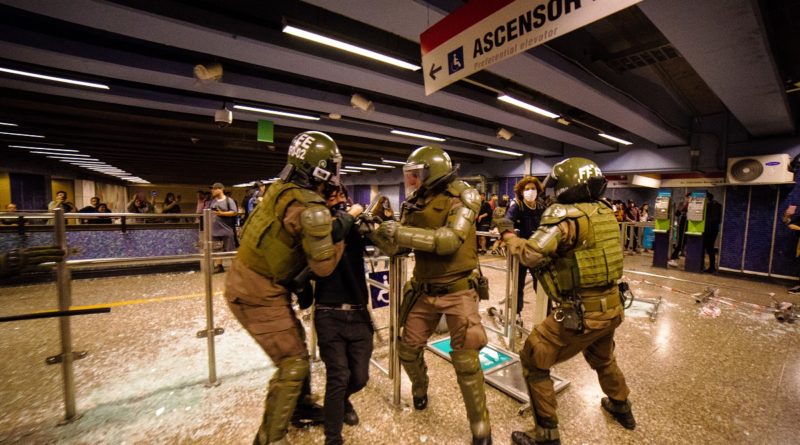Chile and the Economic and Political Violence of the State
by Patricio Zamorano
From Washington DC
The media had to double down through a constant barrage of violent photos and videos arriving through social networks so that especially non-Chileans, who are accustomed to the mythical image of a stable and exemplary country, could internalize and believe the spectacle of fire and blood on their screens.
The president of Chile, Sebastián Piñera, realized a feat impossible to imagine after almost 30 years since the return of democracy: provoke street clashes between Chilean youth, who were not raised during the dictatorship, and military troops, while enforcing a curfew, a state of emergency, and the suspension of some constitutional guarantees. These measures create a ghostly continuum of the dictatorship embedded in the Chilean collective psyche.

The outcome thus far will go down in history: as of October 23rd, the official count is 16 deaths (5 of them by military and police forces), 226 wounded and 1,692 detained.[1] In addition to the human cost, more than 70 metro stations were damaged, with 20 set on fire, and some trains destroyed. A large amount of public and private infrastructure has also been destroyed.
Of course, the analysis by apologists for the government, that this was all a surprise, is meant for foreign consumption. Last weekend Chileans knew all too well what was coming. The population of the country has been subjected to state violence for decades. The images of these past days are the same ones seen during the painful protests of the ‘80s, when the country seethed from the poverty and desperation produced by the political and economic repression of the Pinochet dictatorship. The images recall the state repression inflicted against secondary school students 10 years ago during the so called “Penguin Revolution” (“penguin” is a nickname for students, based on the colors of school uniforms), when children were attacked by police dogs. And the images also remind us of the legal coercive methods such as the violence of the anti-terrorist law applied to the Mapuches in southern Chile.
The president of Chile, Sebastián Piñera, realized a feat impossible to imagine after almost 30 years since the return of democracy: provoke street clashes between Chilean youth, who were not raised during the dictatorship, and military troops, while enforcing a curfew, a state of emergency, and the suspension of some constitutional guarantees.
The Chilean police, called “carabineros,” have always been a repressive force, adding to the other repressive institutions that have converted Chile into a great pressure cooker. The government struggles to maintain a made-up face before the international community. Far from creating a narrative of reconciliation in response to social upheaval, the government uses the idea of “war” against an “internal enemy.”[2] Pinochet used this painful metaphor to justify the violation of human rights of Chileans and provide a moral basis for soldiers to exercise repression directly against their compatriots.

One has to remember that despite the advances of the social agenda since the end of the dictatorship, Pinochet managed to implant neoliberal privatizations that still impact the daily lives of 17 million Chileans. He privatized education and created an underfinanced public sector that compromises the well being of millions of children, condemning them to substandard technical-professional training that leaves them ill-prepared to compete with the sons and daughters of the national elite. He privatized health care making it into a totally regressive system, creating constant desperation for the nation’s majority who must either use the public system — slow, bureaucratic, and of poor quality — or pay for private care. He also privatized pensions, which regressively provides benefits according to the level of one’s lifetime income and personal savings, favoring the privileged.
Social trauma generated by the economic and political model
All of these privatizations have been creating a social trauma that one can breath in on each visit to Chile. It is a feeling of permanent institutional harassment by economic pressures and by the news media. The Chilean soul has been converted into an expression of permanent frustration.
Salaries are at pauper levels. A study by the Sol Foundation shows that 70% of Chileans earn less than $700 dollars per month, and 50% earn less than $500 dollars, little more than the minimum wage.[3] The lives of middle class Chileans are plagued by chronic debt, with millions of people trying to attain a quality of life similar to that projected by the media of those living in higher income neighborhoods.
Chronic debt and generalized depression
Approximately half of the 9 million Chilean workers[4] are in debt.[5] A June 2017 study showed that 31% of those in debt have a financial burden greater than 40% of their income, and 22% of debtors have a financial burden greater than 50%. Also, 43% of debtors have monthly income less than 500,000 pesos, equivalent to a little less than $700 according to present exchange rates.[6] It is simply impossible to make ends meet with peace of mind.
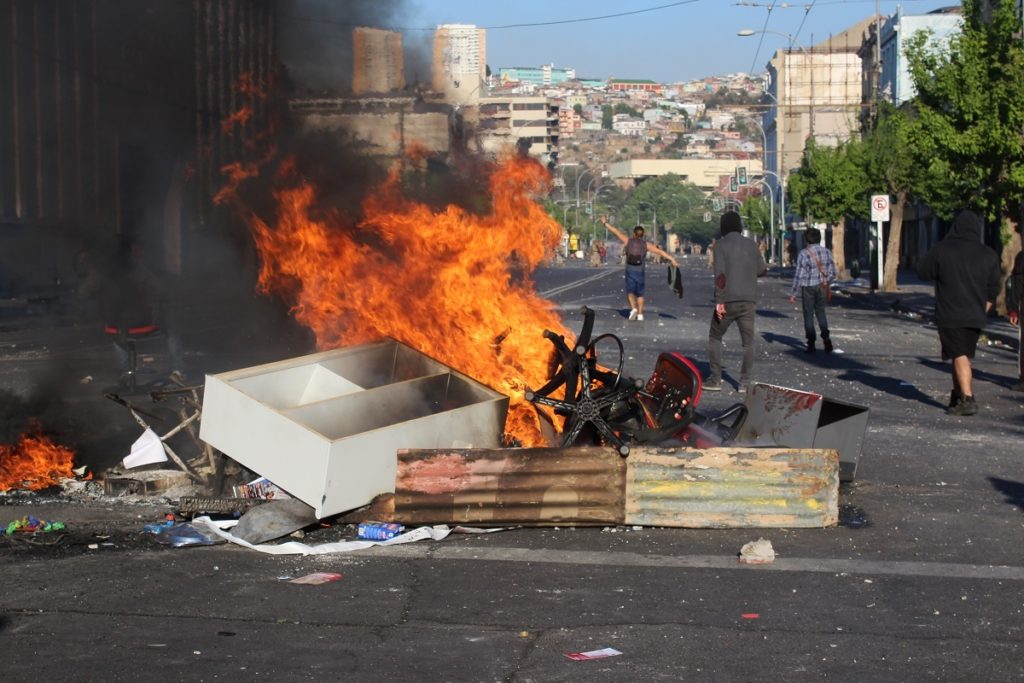
A 2014 international study places Chile in second place in Latin America for credit card debt per capita.[7] Under these conditions, the possibility of saving or spending on leisure are very difficult.
This situation has repercussions for mental health in the country. Chile has one of the highest rates of depression in the world, afflicting more than 18% of the population. And this is a problem affecting mostly the poor in Chile. Mariane Krause, psychologist and director of the Instituto Milenio de Depresión y Personalidad, points out that high income sectors have an 8% rate of depression, while the poor reach a rate of 25%. This is to say, shockingly, that one of every four persons living in poverty suffers from depression in Chile.[8]
The reasons for the social debacle of recent days leaves no room for doubt. The extraordinarily high rate of chronic stress may even be under-represented considering the limited access to mental health services in a privatized system.
Transportation: a sensitive topic
The topic of the cost of riding the metro as well as other public transportation is not merely symbolic or just a matter of an increase of a few cents by decree. One needs to study the details. To figure out the real cost, note that a worker spends on a daily basis between $3 and $6 dollars combined on public transportation, depending on the distance between home and work, and the number of trips taken, for work or other daily activities (picking up children from school, errands, emergencies, shopping, etc.). This is between $60 and $120 per month. About 50% of workers earn less than 500,000 pesos, a little less than $700 per month. If a father or mother are the only breadwinners, and there is a son or daughter that needs paid transportation, for example, to attend university or take care of some business or go out to eat some night . . . the picture emerges of constant financial pressure on millions of families.
Let’s compare this to a city like Washington, DC. A young worker with some experience can aspire to a salary of $4,000 per month. The metro in DC is expensive and in one day can cost about $10 for two trips or $200 per month. Yet that cost does not come to even 5% of monthly salary of the worker in Washington.
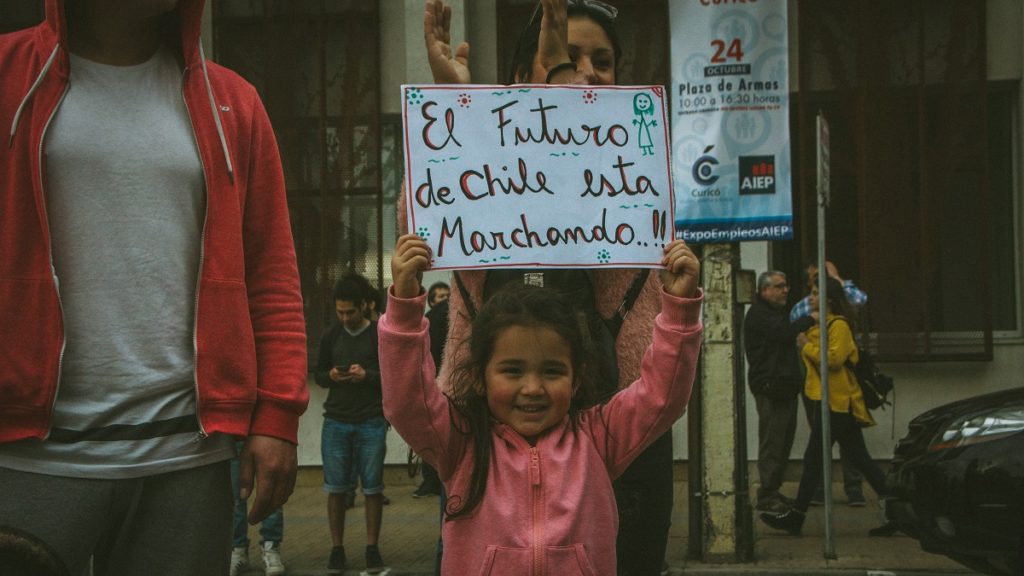
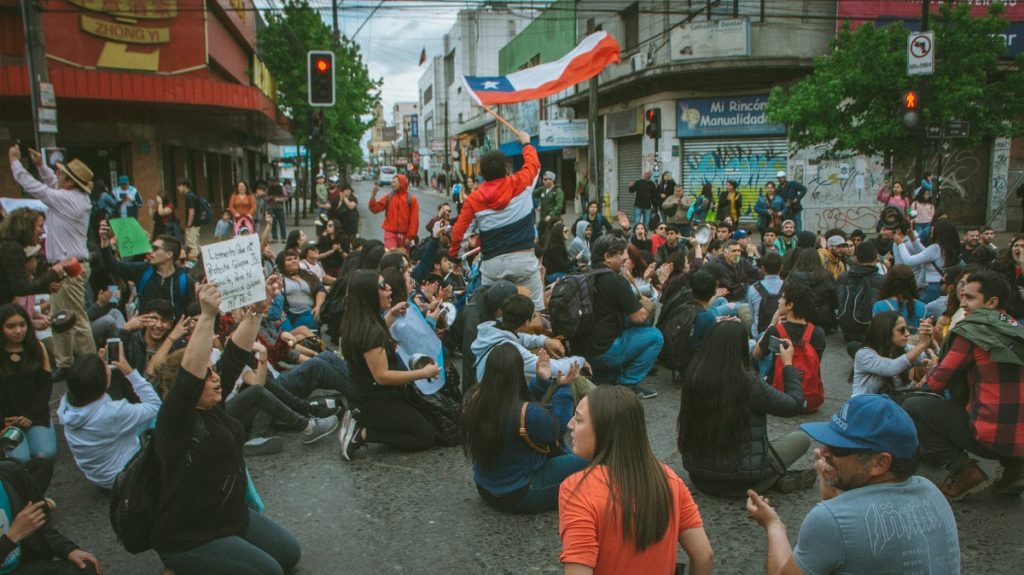

Chile: the same recipe as Ecuador and Argentina
This system of institutional violence is based on the impunity of the elite. As Professor Javier Ruiz Tagle of the Universidad Católica points out, the extent of sacking of public funds revealed by prosecutions of large Chilean corporations has exceeded $4 billion over the last few years.[9] This includes tax evasion, price fixing, and illegal monopolies, all of which involve large business groups, including that of Piñera himself.
The social explosion under the government of Piñera is not isolated from the international context. In Ecuador, the government of Lenin Moreno has reversed the social policies of his progressive predecessor, Rafael Correa. Moreno, for example, decreed a tax amnesty for the bank system and other large corporations that have not paid taxes for decades. This loss in State revenue comes to more than $4 billion.[10] Lenin Moreno transferred this debt of the private finance sector to the Ecuadorian people, along with the elimination of gas subsidies. This blow to the population was felt immediately only a few days ago, especially among the indigenous peoples. More than 500 were wounded and several killed. This was a crude reminder of the instability suffered by Ecuador for decades and the cost of the structural adjustment package and conditions imposed by the International Monetary Fund (IMF). The approval rating of Lenin Moreno has fallen to as little as 20%, one of the worst on the continent.[11]
A parallel situation has occurred in Argentina. The fiscal and monetary policies of President Macri have dismantled almost entirely the subsidies and social programs of the former progressive government.[12] Macri eliminated subsidies for public transportation, water, natural gas, and electric services, provoking a 500% rise in the cost of the latter.[13] The looting and despair could not wait.[14] Just this past month, an enormous demonstration demanded measures that would stave off hunger among the population.[15] The IMF is also behind these fiscal policies of austerity in social spending, despite the fact that the banking system brought in $170 billion in profits in 2018, 120% more than the 2017 figure.[16] What is the result of these social policies? The poverty rate in Argentina exceeds 30%,[17] childhood poverty is at 50%, and one in six children experiences hunger.[18]
Chile’s regressive tax system: economic violence
In Chile, the neoliberal economic model, has been perpetuated by all presidents (including the socialists Lagos and Bachelet) since the Pinochet dictatorship without any significant structural changes The taxation feature of this model places excessive weight on citizens and a minimal burden on companies. More than 40% of the tax collection in Chile comes from VAT (sales tax for products and services). The burden falls on citizens, not companies. This regressive and unfair situation disproportionately affects the most vulnerable. People with higher incomes only represent 9% of tax revenue[19]. Companies in Chile also have great advantages when filing taxes that, in some cases, allow them to pay as little as 0%[20] . Companies in the mining sector, one of the most important sources of revenue for the country, have also greatly benefited. According to a study by economist Eduardo Titelman, between 2004 and 2009, the state stopped receiving more than $10 billion due to special dispensations offered to mining companies, privileges that few Chileans have[21] .
Everything leads to inequality. According to a 2019 ECLAC report, the richest 1% of Chile hold 26% of the nation’s wealth[22] . And Chile ranks seventh among the most unequal countries on the planet, as reported by the World Bank in 2018[23] .
More than 40% of the tax collection in Chile comes from VAT (sales tax for products and services). The burden falls on citizens, not companies. This regressive and unfair situation disproportionately affects the most vulnerable. People with higher incomes only represent 9% of tax revenue
The economic model then, is based on a regressive tax policy that exacerbates inequality. The system is so rooted in the Chilean socio-political culture, that there are no institutional mechanisms in place to transform this model of economic violence into one that is more equitable and fair. The electoral route, in that sense, has been totally incapable of bringing about a change that benefits the whole country. Street mobilization and violence appears, then, as the only way out, the cry of despair in the face of the chronic stress of daily life. And as we have seen, other governments in the region, also faced with the lack of substantive tools to respond to these crises, are also resorting to extraordinary measures such as, in the case of Piñera, using curfews, military troops, the state of emergency or the anti-terrorism law.
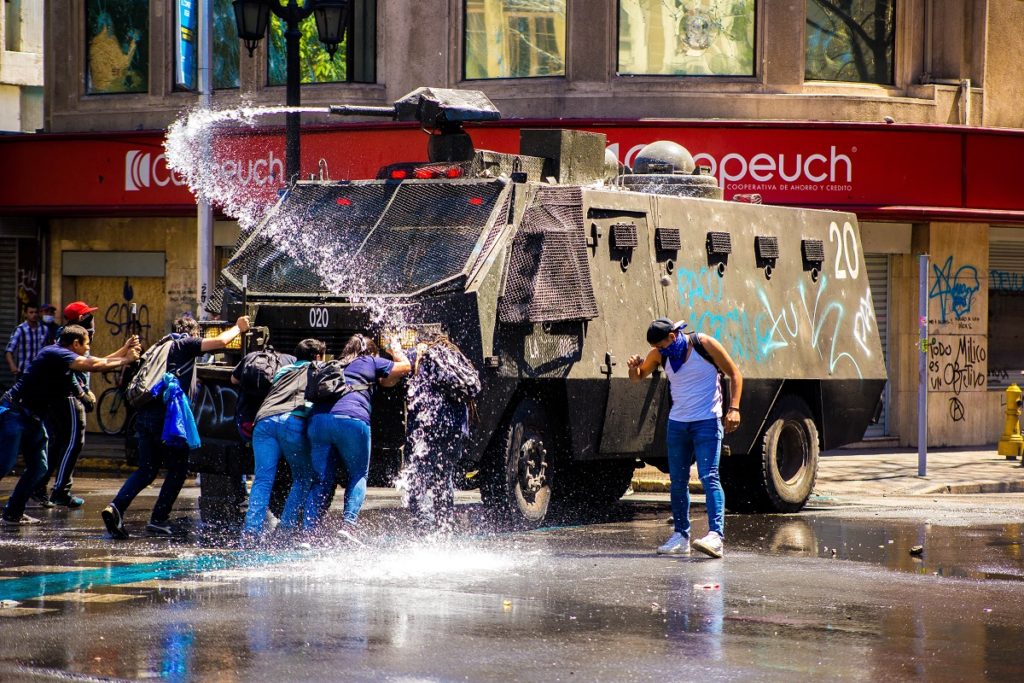
A fury fueled by 30 years and the recipe for change
As in the cases of Argentina and Ecuador, both governed by right-wing presidents, Piñera impacted a basic service of critical importance to the population, by increasing the price of the Metro ticket and the public transportation system of Transantiago. Although the increase was only a few cents, it precipitated the people’s fury against “30 years of state violence”, as the popular slogans on the streets say. Piñera and the powerful financial sector he represents are incapable of providing a solution to the Chilean problem. Chileans gain nothing by appealing to Piñera for a lasting solution; it would be tantamount to shooting themselves in the foot.
The recipe is clear: the corporate groups ( Angelini’s, Luksic’s, Piñera’s and a long etcetera), must voluntarily cede part of their factual power and allow a real tax reform that floods the state coffers.
The privatization of the health system must be reversed immediately, and a universal insurance system must be created that covers all the needs of the population. That is, health care is a human right. It is not necessary to reinvent the wheel: it prevails in Canada, Europe, and even in embargoed Cuba.
The pension system must also be universal, although mixed variants should be allowed that provide the option of private pension accounts for those who can collect more as a fair reward for their previous income. But the state must guarantee a fair and substantial fund for every retiree in the country. All proceeds from the investment operations of these public funds must be returned to each citizen.
And the salary structure must be urgently reformed. The objective is to create income and consumption conditions that foster a strong domestic market, unlike the one now based on chronic indebtedness. The structure of consumption in Chile is based on the permanent debt of the middle and working classes, which is not only unsustainable but keeps the domestic market permanently depressed. The current equation exhausts the population by a constant sense of job insecurity, harming productivity, professional morale, and the quality of life of families. If large business groups want more commerce, more dynamism, more production, it is incomprehensible why they opt for the economic repression of millions of potential consumers. Simply put, there is conformity with the current profit levels, and even greater conformity with the submissive passivity suffered by millions of workers in the country.
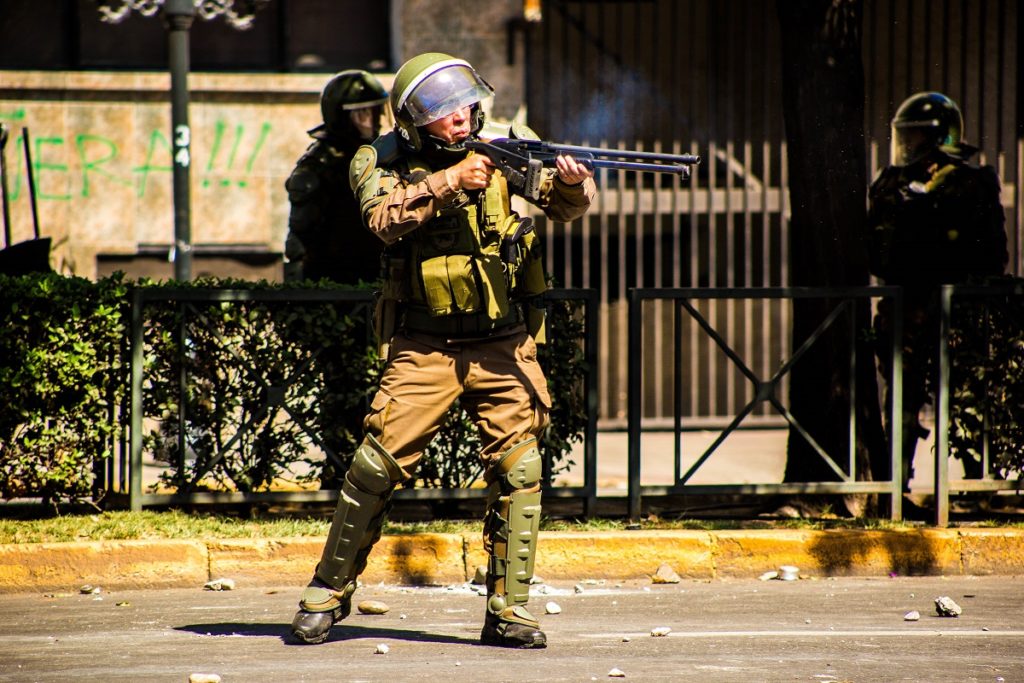
Economic freedom, only for the elite
The most important challenge is to produce a new mindset of the Chilean business elite. By supporting and financing the political and economic values of the Pinochet dictatorship, the holders of big Chilean capital opted for repressive and often lethal social control by the State, while pretending to advance the values of individual development and “freedom” championed by free market economists Milton Friedman and his followers. Non-intervention of the State in the economy is a myth. In reality, the State intervenes strongly to guarantee a permanent position of economic privilege of a specific sector of the population. The way in which this logic has been developed for more than four decades leaves no doubt. There is no interest in developing the productive potential of the Chilean people. There is a huge distrust in the population that is perceived by the ruling elites as a mass that must be controlled and rendered docile.
By supporting and financing the political and economic values of the Pinochet dictatorship, the holders of big Chilean capital opted for repressive and often lethal social control by the State, while pretending to advance the values of individual development and “freedom” championed by free market economists Milton Friedman and his followers.
Chile’s low quality and expensive private health system keeps them sick and indebted with the private hospital system. The educational system frustrates the vast majority of young people and keeps them under-employed and under-educated. They are locked in a stagnant and insufficient salary structure, which prevents the accumulation of capital and savings, and truncates the possibility of sufficiently financing leisure, spiritual and creative activities. The electoral system does not provide an avenue for profound structural changes. It does not matter if the governments are nominally socialist, social democratic or right-wing; oligarchic rights are maintained at the expense of civil society. The law and constitutional coercive measures are used to crush the expression of social protest, leaving the door open to the raw expression of violence.
The Chilean explosion this weekend is not
a new phenomenon. It has always been present, latent, sometimes submerged, but
ready to overflow the streets. The international community generally
misconstrues Chilean reality, convinced by the mirage created by macroeconomic
figures. Thus Santiago suffers, destroyed and rebuilt several times a year, in
a cadence of rage that has already become a painful litany. The Chilean people,
hardworking and persevering in a land full of natural calamities, political
calamities and social calamities, got tired this October of 2019, of turning
the other cheek.
Patricio Zamorano is a singer-songwriter, journalist and academic in political science. He is also Co-Director of COHA.
End notes
[1] INDH anuncia querellas por cinco personas fallecidas en Estado de Emergencia. https://www.indh.cl/indh-anuncia-querellas-por-cinco-personas-fallecidas-en-estado-de-emergencia/
[2] Presidente Piñera: Estamos en guerra contra un enemigo poderoso. https://www.telesurtv.net/news/pdte-pinera-estamos-guerra-contra-enemigo-poderoso-20191020-0047.html
[3] “Los verdades sueldos de Chile”. http://www.fundacionsol.cl/estudios/sueldos-chile-2018/
[4] Banco Mundial. https://datos.bancomundial.org/indicator/SL.TLF.TOTL.IN
[5] SBIF realiza radiografía del endeudamiento en Chile https://www.sbif.cl/sbifweb/servlet/Noticia?indice=2.1&idContenido=11889
[6] SBIF realiza radiografía del endeudamiento en Chile https://www.sbif.cl/sbifweb/servlet/Noticia?indice=2.1&idContenido=11889
[7] Chilenos tienen la segunda mayor deuda en tarjetas de Latinoamérica. http://www.economiaynegocios.cl/noticias/noticias.asp?id=124482
[8] MARIANE KRAUSE: “Chile requiere un cambio sociocultural para superar la depresión” https://www.conicyt.cl/blog/2019/02/01/mariane-krause-chile-requiere-un-cambio-sociocultural-para-superar-la-depresion/
[9] La cifra de la indignación: Académico calcula en más de cuatro mil millones de dólares las pérdidas que sufrió el Estado en beneficio de unos pocos. https://www.eldesconcierto.cl/2019/10/20/la-cifra-de-la-indignacion-academico-calcula-en-mas-de-cuatro-mil-millones-de-dolares-las-perdidas-que-sufrio-el-estado-en-beneficio-de-unos-pocos/
[10] Ecuador: gobierno de Lenin Moreno sacrifica a los sectores empobrecidos para satisfacer al FMI. https://coha.org/ecuador-gobierno-de-lenin-moreno-sacrifica-a-los-sectores-empobrecidos-para-satisfacer-al-fmi/
[11] Consultora Mitofsky. https://radioequinoccio.com/inicio/item/9179-presidente-lenin-moreno-con-pesima-aprobacionsegun-consultora-mexicana.html
[12] Macri persiste en su política de eliminar subsidios a los servicios. https://www.elciudadano.com/latino-america/argentina/macri-mantiene-su-politica-de-eliminar-subsidios-a-los-servicios/05/31/
[13] Gobierno de Macri elimina subsidios a electricidad, se esperan alzas de hasta 500% https://www.eltelegrafo.com.ec/noticias/mundo/8/argentina-aumentodeprecios-luz-tarifazo-macri
[14]Crisis económica en Argentina: Intento de saqueo terminó con un niño de 13 años muerto por herida de bala. https://www.eldesconcierto.cl/2018/09/04/crisis-economica-en-argentina-intento-de-saqueo-termino-con-un-nino-de-13-anos-muerto-por-herida-de-bala/
[15] Argentina y una semana marcada por protestas que exigen la emergencia alimentaria https://www.france24.com/es/20190911-argentina-protestas-emergencia-alimentaria-crisis
[16] El sector financier sigue siendo el gran ganador de la era Macri. https://www.infobaires24.com.ar/el-sector-financiero-sigue-siendo-el-gran-ganador-de-la-era-macri/
[17] Argentina se hunde en la pobreza mientras el dólar se dispara. http://www.rfi.fr/es/americas/20190429-argentina-se-hunde-en-la-pobreza-el-fmi-aplaude
[18] Más de la mitad de los niños argentinos son pobres. https://elpais.com/internacional/2019/06/07/actualidad/1559927136_602178.html
[19] Chile recauda cuatro veces más impuestos por el IVA que por lo que pagan los más ricos. https://www.publimetro.cl/cl/noticias/2017/11/24/chile-recauda-cuatro-veces-mas-impuestos-iva-lo-pagan-los-mas-ricos.html
[20] Cómo y por qué el gobierno permitirá a las empresas no pagar impuesto corporativo. https://ciperchile.cl/2019/07/18/como-y-por-que-el-gobierno-permitira-a-las-empresas-no-pagar-impuesto-corporativo/
[21] Los enormes beneficios tributarios a los que acceden las empresas mineras en Chile. https://ciperchile.cl/2011/07/19/los-enormes-beneficios-tributarios-a-los-que-acceden-las-empresas-mineras-en-chile/
[22] Cepal describe a Chile como un país desigual: Un 1% concentra el 26,5% de la riqueza https://www.cnnchile.com/pais/cepal-describe-a-chile-como-un-pais-desigual-un-1-concentra-el-265-de-la-riqueza_20190116/
[23 ] Aparece Chile: estos son los 10 países más desiguales del mundo. https://www.biobiochile.cl/noticias/nacional/chile/2018/07/04/aparece-chile-estos-son-los-10-paises-mas-desiguales-del-mundo.shtml

